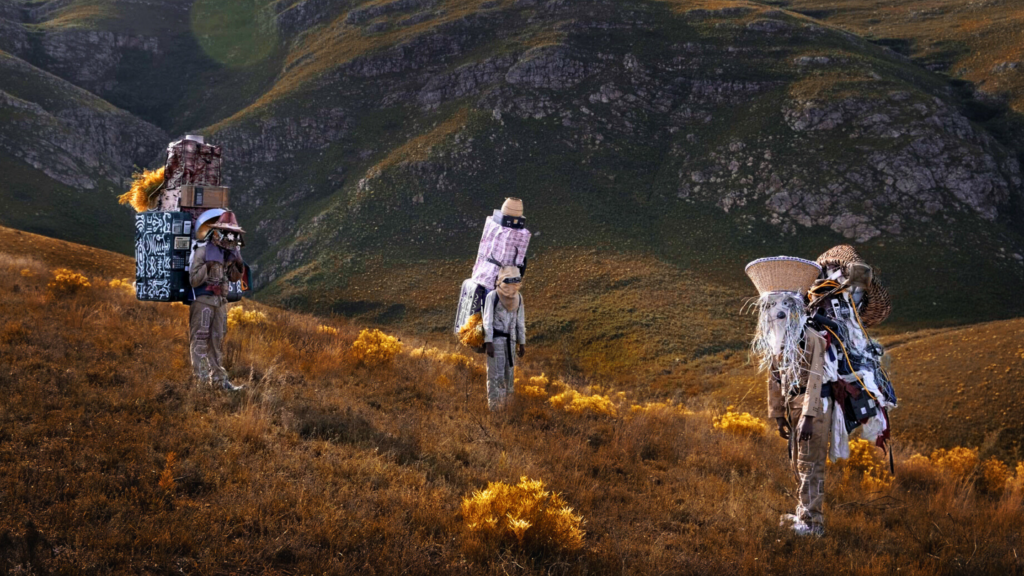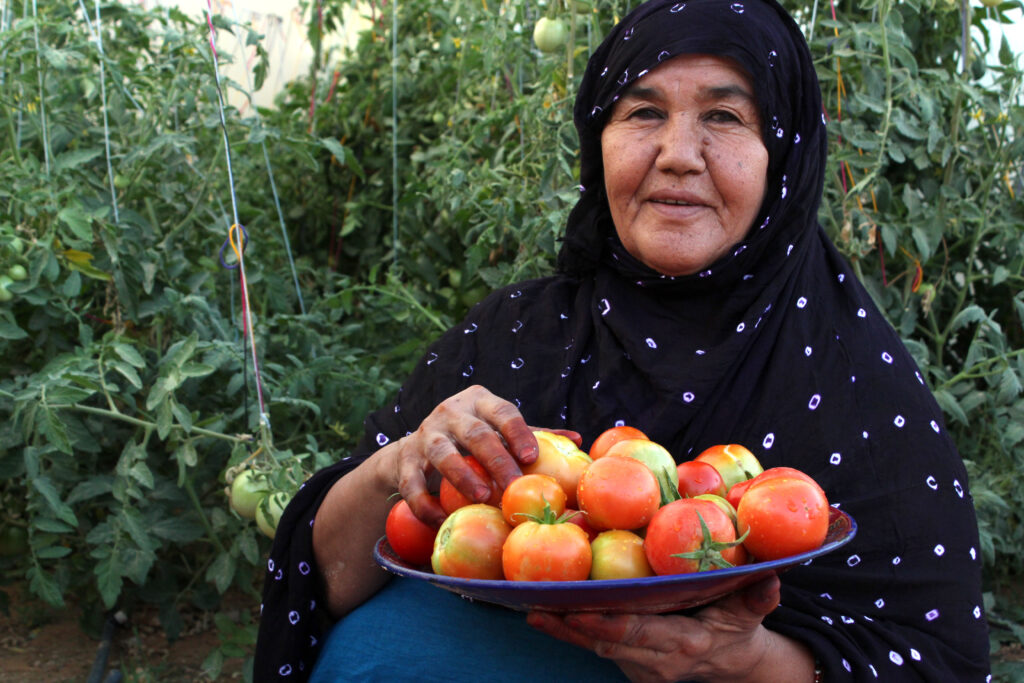- Press release as PDF
- STARTS Prize Africa & Jury 2024
- Winners 2024 inkl. Jury Statement
- Interview mit CATPC via Ars Electronica Blog
- Photos via Flickr
- Ars Electronica Festival 2024
(Linz/Brussels, June 25, 2024) The first STARTS Prize Africa received 405 submissions from 35 countries. The European Commission’s new initiative aims to promote innovation in Africa and future cooperation between Africa and Europe. Ars Electronica was commissioned to organize the competition.
A Grand Prize worth 15,000 euros and five Awards of Distinction worth 3,000 euros each will be awarded. An international jury, which included Andrea Barschdorf-Hager, Mónica Bello, Oscar Ekponimo, Judith Okonkwo, and Kathleen Siminyu, decided who will be the lucky winners in 2024. They were supported by nine advisors: Tegan Bristow, Eduardo Cachucho, Letaru Dralega, Femi Johnson, Marcus Neustetter, Azu Nwagbogu, Rosie Olang’ Odhiambo, Azza Satti, and Neri Torcello.
Grand Prize for Balot NFT
The Grand Prize goes to the project Balot NFT by the Congolese initiative Cercle d’Art des Travailleurs de Plantation Congolaise (Art Circle of Congolese Plantation Workers). The award recognizes an innovative model of restitution that uses NFTs to re-collectivize African cultural assets, making them a tool of the decolonization movement.
Five Awards of Distinction for innovative and interdisciplinary projects
The five Awards of Distinction of STARTS Prize Africa go to Black Body Radiation: Rescripting Data Bodies by Ama BE (GH/US) and Ameera Kawash (PS/US), Dzata: The Institute of Technological Consciousness by Russel Hlongwane (ZA), Francois Knoetze, and Amy Wilson – Lo-Def Film Factory (ZA), I.AM.ISIGO Digital Mystery System by Bubu Ogisi (NG), Sand Gardens by Mohamed Sleiman Labat (EH), and The Metadata Memoir by Minne Atairu (NG).
Exhibition at the Ars Electronica Festival 2024
The winning projects from the first STARTS Prize Africa will be on display as part of an exhibition at the Ars Electronica Festival 2024 from September 4 to 8. The official award ceremony of the STARTS Prize Africa is part of the Prix Ars Electronica Award Ceremony and will take place on Thursday, September 5, 2024, from 7:30 p.m. in the Design Center Linz.
International Network
The STARTS Prize Africa bundles the expertise of diverse partners. Embedded in the EU project STARTS4AFRICA, European actors such as Ars Electronica, INOVA+, GLUON, and PiNA work together with decision-makers in Africa to promote collaboration between artists and regional actors. Participants include: Emerging Communities Africa, Buni Hub, hapaFoundation, Picha, and the Goethe Institut Nigeria. The joint effort is intended to underline the potential of collaborative approaches and strengthen fruitful relationships between technology, art and culture.
S+T+ARTS Prize Africa
The STARTS Prize, initiated by the European Commission in 2016, has made a significant contribution to laying the foundations of a community that today connects artists, companies, scientists, and researchers. The aim of the newly launched STARTS Prize Africa, is to further strengthen these efforts and, in the future, to highlight and award regional African best practices in this area.
The STARTS Prize Africa rewards and supports initiatives that work towards a positive social, humanitarian, economic or political impact and promote a diverse and sustainable society. The emphasis is on efforts that focus on pressing problems on the continent and facilitate digital transformation in the creative sector.
STARTS4AFRICA is funded by the European Union under the STARTS – Science, Technology and Arts initiative of DG CNECT (GA no. LC-01960720). Views and opinions expressed are those of the author(s) only and do not necessarily reflect those of the European Union or DG CNECT. Neither the European Union nor the granting authority can be held responsible for them.
S+T+ARTS PRIZE AFRICA ’24
Grand Prize
Awarded for artistic exploration and art works where appropriation by the arts has a strong potential to influence or alter the use, deployment or perception of technology.
Balot NFT / Cercle d’Art des Travailleurs de Plantation Congolaise—CATPC (CD)
„The question of ownership, and especially the ownership of cultural artifacts, is of great importance for the African continent. One big question for us is, “How can we both digitize our cultures as well as ensure that we can maintain ownership of these artifacts?” The project is also a new spin on restitution, one that is proactive. CATPC shows that while we should continue to demand that what is ours be returned to us, we can and perhaps should do more than just wait. They have taken back what is theirs by minting the digital art version, and owning it.“
Excerpt from the jury statement
While museums in the Global North are using NFTs to further promote the privatization of art objects, the Cercle d’Art des Travailleurs de Plantation Congolaise (Congolese Plantation Workers Art League – CATPC) initiative is using them to re-collectivize stolen works of art.
The focus is on the Balot sculpture, which was carved by rebellious Pende people in 1931. After years of oppression and exploitation by Belgian plantation owners, the rape of the wife of a Pende chief triggered a revolt, during which the colonial administrator Maximilien Balot was attacked by the angry crowd, killed, beheaded, and dismembered. Before the uprising, which lasted several months, was brutally suppressed by the Belgian army, the Pende carved a wooden figure about 60 centimeters tall that was intended to contain spiritual powers and serve the community. After the riot, the statue disappeared. It resurfaced in 1972 and was purchased by Herbert F. Weiss, then a political scientist at the City University of New York and a collector of art objects. In 2017, Weiss sold the statue to the Virginia Museum of Fine Arts (VMFA), which owns it today.
Since 2020, CATPC has made several loan requests to exhibit the sculpture at the White Cube Museum in Lusanga. Because these requests were all rejected or not answered, CATPC began looking for alternative ways to reclaim the sculpture and its meaning for the Pende descendants.
Members of CATPC used photos from the VMFA website to create a digital Balot sculpture floating above the fragment of a drawing by Ced’art Tamasala. The drawing maps global value flows of capital, goods, and cultural exploitation. The digital work has been turned into NFTs that are available for purchase. With the proceeds of these NFTs, CATPC is buying back Pende land that was seized and depleted by colonial plantation owners for 100 years. The goal is to restore the sacred forest of their ancestors. Each NFT is therefore sold for the price of one hectare of land and helps pursue the original purpose of the Balot sculpture: to protect or restore the Pende community and land.
In 2024, CATPC obtained a temporary loan of the Balot sculpture to display in the White Cube. The sculpture will be on display at Lusanga from April 20 to November 24, 2024, while also being connected via a livestream to the Rietveld Pavilion at the 2024 Venice Biennale.
Balot NFT is an innovative model for collective ownership—particularly that of indigenous knowledge and cultural heritage—in the digital world. Furthermore, it represents a new and proactive form of restitution. CATPC advocates for museums and art institutions worldwide to support reconciliation and work with indigenous communities. With the sale of the Balot NFTs as well as the temporary return of the Balot sculpture, the CATPC movement is reclaiming what belongs to them: not just art, but also land.
Credits
The Balot NFT is created by CATPC and supported by Human Activities.
Human Activities takes care of the technical, legal, and financial production.
All sale proceeds and resale royalties, minus gas fees, go to CATPC for the acquisition and restoration of land.
S+T+ARTS PRIZE AFRICA ’24
5 Awards of Distinction
Black Body Radiation: Rescripting Data Bodies / Ama BE (GH/US), Ameera Kawash (PS/US)
“The work tackles the reality of non-consent where our interaction with technology is concerned. Through wearable devices and as we navigate our smartphones, data pertaining to our movement and activity is recorded. We do not view this as work because we are simply going about our daily lives, but we are in fact engaged in extremely valuable work, that of creating data. . […] This work is unvalued despite the fact that it goes on to create great value for those who aggregate the plethora of our invisible efforts. As the value is realized, the input of the many is downplayed. There is no remembrance or acknowledgement. Black bodies have been used, misused, abused. They have always been the least valued. As our world evolves, so do the ways in which bodies can be used, misused, and abused.”
Excerpt from the jury statement
The collaborative art project *Black Body Radiation: Rescripting Data Bodies* by Ameera Kawash and Ama BE consists of a series of performances that revolve around material and ritual aspects of tobacco as a commodity and sacred material. The project uses sensors that are worn on the body during performances and measure and record heart rate, body temperature, and oxygen levels in the blood. This and other data is processed using blockchain architectures and converted into digital assets that open up new possibilities for choreography, documentation, and financing of live performances.
As soon as Ameera Kawash attaches the sensors to Ama BE, she expressly agrees to the collection and use of her biometric data. Because this data is stored in a blockchain, physical exertion is also recorded precisely: the NFTs generated reflect the value of breaths, effort, and performance duration.
Ameera Kawash and Ama BE address the mass collection and use of our data, which often takes place without our knowledge and without our consent. Although this data creates enormous value, we as data producers are not recognized, let alone involved in the value creation. The project also points to the historical exploitation of Black bodies, which were used and abused, and always disregarded.
Credits
Digital designer, video editor, concept: Ameera Kawash
Performance art and design, concept: Ama BE
Camera: Enrique Huaiquil
Dzata: The Institute of Technological Consciousness / Russel Hlongwane (ZA), Francois Knoetze und Amy Louise Wilson – Lo-Def Film Factory (ZA)
“Dzata uses film for storytelling to reimagine Africa’s technological past through the lens of a theoretical “fictional Institute of Technological Consciousness” that investigates the idea of invention and innovation as a component of a continuous, interconnected process of accumulated knowledge.”
Excerpt from the jury statement
Dzata: The Institute of Technological Consciousness is an artistic research project by South African artists Russel Hlongwane, Francois Knoetze, and Amy Wilson. From the perspective of a fictional research institute and its archives, they look at centuries-old technological practices from across Africa. The project builds on the work of Clapperton Chakanetsa Mavhunga, professor of science, technology and society at MIT in Boston, and includes a video, text, sculptural masks, costumes, equipment, and a workshop series for youth.
Dzata: The Institute of Technological Consciousness focuses on indigenous technological knowledge and explores the role of science, technology and innovation in knowledge accumulation. The project does not invent anything new, but rather brings current thinkers, anti-colonial revolutionary practices, technologies, and traditions into dialogue with one another. The aim is to stimulate reflection and interpretation of innovation and modernity that is developed by African cultures themselves and not adopted from outside.
Equally immersive and entertaining, Russel Hlongwane, Francois Knoetze, and Amy Wilson challenge the notion that Africa is merely a consumer of technology and show that many technological innovations were here long before colonization.
Credits
Written and directed by: Francois Knoetze, Russel Hlongwane + Amy Louise Wilson
A Lo-Def Film Factory & Substance Point Production
Supported by the Mozilla Foundation Creative Media Award & Mozilla Alumni Connection Fund
I.AM.ISIGO Digital Mystery System / Bubu Ogisi (NG)
“The significance of this project lies in its ability to bring ancient weaving practices into the present, seamlessly connecting these archives to the digital network. It serves as a bridge between science, spirituality, and creative practice, highlighting the rich cultural heritage of African weaving techniques.”
Excerpt from the jury statement
The I.AM.ISIGO Digital Mystery System is an innovative digital project that bridges the gap between the physical and digital worlds to preserve and disseminate knowledge of ancient weaving techniques in Africa. On the one hand, it serves as a digital archive and on the other hand as an interactive platform on which traditional weaving patterns can be explored and learned. The boundaries between science, spirituality, and creative practice are blurring. The project explores rural places and communities where these cultural techniques emerged, as well as cities where weavers work and sell their products today. The research extends from remote rural areas to cities such as Nairobi, Kano, Tamale, Dakar, Bolgatanga, Ibadan, Lagos, Agbozume, Kpalimé, Divo, and Cotonou.
Both the scope and methodology of I.AM.ISIGO Digital Mystery System are groundbreaking. It documents and preserves weaving practices, examines the processing and use of materials, and archives this knowledge for future generations. At the same time, the project makes weaving accessible to a global audience. By uncovering old government systems and exploring the entire supply chain, a comprehensive view of material knowledge systems also opens up. The documentation and digitization of old weaving techniques contribute equally to the preservation of cultural techniques and future innovation.
Credits
Creative direction: Bubu Ogisi
Coding: Uzoma Orji, Uzoma Studios
Art direction: Tushar Hathiramani
Developer operations, management: Kolade Ayo-Vaughan
Sand Gardens / Mohamed Sleiman Labat (EH)
”Awarding this community project recognizes the Sahrawi people’s determination and resilience. It sheds light on their adaptive strategies and the innovative spirit that enables them to cultivate life in one of the most inhospitable places on earth. The project serves as a powerful reminder of the human capacity to persevere and innovate, even in the face of extreme adversity.”
Excerpt from the jury statement
As a result of the colonial exploitation of phosphate deposits in Western Sahara, the Sahrawi were expelled from their homeland and now live in refugee camps in the south of Algeria. The film DESERT PHOSfate shows the resilience and innovative ability with which they defy the adversities of the Hamada Desert and their fate. Symbolic of their resistance are the Sand Gardens or Sandoponic gardens, where the Sahrawi cultivate vegetables and herbs in sand. This is made possible by plastic films on which condensation forms, which is collected using a drainage system and reused. The gaps between the sand grains allow water to penetrate the soil more quickly and improve the oxygen supply to the roots of the plants. The lack of phosphate in the soil is compensated for by fertilizing with animal dung and food scraps.
The family gardeners movement is initiated and led by the Sahrawi agricultural engineer Taleb Brahim, whose experiments always target specific problems and use locally available materials and technologies. While the Sahrawi previously relied entirely on food aid, thanks to the Sandoponic gardens they now have access to healthy and nutritious food.
The film DESERT PHOSfate tells the story of the Sahrawi, honors their resilience, and celebrates their resistance. The film reminds us of our ability to survive even in extreme situations and inspires people around the world to find creative solutions to meet current planetary challenges.
Credits
Motif Art Studio
Algaada Centre for Small Scale Farming and Agricultural Research
The film DESERT PHOSfate is part of the PHOSfate Artistic Research Project together with Pekka Niskanen, funded by Kone Foundation, Osker Öflunds Stiftelse, and Arts Promotion Centre Finland.
The Metadata Memoir / Minne Atairu (NG)
“Restitution as a concept requires that the process of returning stolen items to African governments and organizations be conducted in an open and transparent manner. Governments, museums, and other cultural institutions work together in the current movement to repatriate looted artifacts. The Metadata Memoir sheds light on the importance of community ownership and public trust for both the restitution procedure and the returned objects.”
Excerpt from the jury statement
During the British invasion of the Kingdom of Benin in 1897, over 4,000 cultural artifacts were stolen and are now owned by private collectors and around 160 cultural institutions worldwide. Although efforts to repatriate the “Benin Bronzes” have now achieved initial success, information about them is usually not made public or is concealed. Western museums are also required to delete records after repatriation.
The Metadata Memoir is an innovative response to this lack of transparency. The decentralized archive system is based on a smart contract (a computer program that runs automatically when certain conditions are met) and uses programming interfaces from the New York Times and the Guardian to find news about repatriated Benin Bronzes. The system automatically documents all available information, including the date of repatriation, the name of the repatriating institution, and the name, material composition, and date of manufacture of the object in question. To date, 64 returns have been recorded from eight institutions, including the Metropolitan Museum of Art in New York and the Smithsonian National Museum of African Art in Washington DC.
The Metadata Memoir provides full information on the repatriation of the stolen Benin Bronzes in Nigerian Pidgin English and Standard English. The project highlights the importance of public trust and community ownership in the repatriation of cultural artifacts. The clever application of blockchain technology creates a decentralized archive of metadata that allows anyone interested to track the path and return of artifacts. In addition, The Metadata Memoir aims to raise awareness that the theft of art historical artifacts was not carried out in the distant past, but by organized, modern societies that comprehensively documented the profits they made. The project connects the past and the future and makes the present reality visible in the essence of the colonial era.

Balot NFT / Cercle d’Art des Travailleurs de Plantation Congolaise—CATPC (CD)
Photo: Balot NFT #140; CATPC, 2022

Black Body Radiation: Rescripting Data Bodies / Ama BE (GH/US), Ameera Kawash (PS/US)
Photo: Courtesy of the Artists, Ama BE, Ameera Kawash



